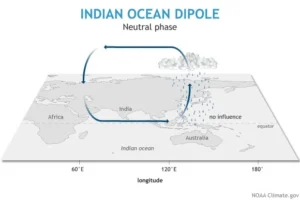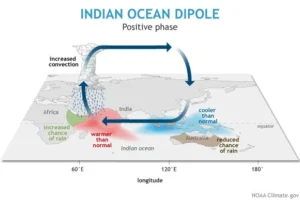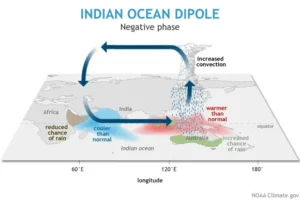Indian Ocean Dipole (IOD)
- Context: The World Meteorological Organisation (WMO) in its Global Seasonal Climate Update for March-April-May 2024 has reported that the Indian Ocean Dipole (IOD) index is predicted to stay positive but is anticipated to return to near normal.
Analysis
- The Indian Ocean Dipole (IOD) refers to the swing in sea-surface temperatures from warm to cool and vice-versa between the eastern and the western parts of the Indian Ocean to the South of Sri Lanka.
- The IOD occurs in the relatively smaller area of the Indian Ocean (than the El Nino in the Pacific Ocean) between the Indonesian and Malaysian coastline in the east and the African coastline near Somalia in the west.
- This east-west contrast in ocean conditions (a “dipole”) alters the wind, temperature, and rainfall patterns in the region.
- IOD events usually originate in the months of April and May, however, these events occur irregularly and vary in strength and duration.
- The IOD is an ocean-atmosphere interaction very similar to the El Nino fluctuations in the Pacific Ocean. Therefore, sometimes referred to as the “Indian Nino”.
- It is, however, a much weaker system than El Nino, and thus has relatively limited impacts.
- IOD cycles through phases referred to as “positive”, “neutral” and “negative”.
Read also: UPSC Current Affairs: Sabina Shoal, Project NAMAN, D-Voter, Solar Paraboloid Technology, and More
Neutral Phase of the IOD
A neutral phase would mean sea temperatures were close to average across the India

Positive Phase of the IOD

- IOD is said to be positive when the western side of the Indian Ocean, near the Somalia coast, develops warmer-than-normal conditions than the eastern Indian Ocean near the Indonesian and Malaysian coastlines.
- In this phase, Indonesia and Australia tend to be drier than normal, which increases the chances of bushfires, while eastern Africa and India tend to be wetter than normal, increasing the likelihood of floods.
- The positive IOD event is known to help the South-West monsoon. A positive IOD leads to greater monsoon rainfall and more active (above normal rainfall) monsoon days while negative IOD leads to less rainfall and more monsoon break days (no rainfall).
- The 2019 was one of the strongest positive IOD events on record. It was developed in May 2019, and drove the India monsoon to excess and extended it into October.
- During an early IOD, the combined effect of Arabian sea evaporation and stronger cross equatorial flow — winds blowing from the southern tropics to the north across the equator — play an important role in enhancing the monsoon activity over the Indian subcontinent.
- A positive IOD does have the potential to offset the impacts of El Nino (associated with decrease in rainfall) to a small measure in neighbouring areas, and it has, at least once in the past (1997), delivered admirably on this potential.
- Further, it has been found that during a positive IOD and an El Nino event, the monsoon rainfall over India is likely to be above normal.
- In contrast, during a negative IOD and an El Nino event, the monsoon rainfall over India is likely to be below normal.
UPSC Current Affairs: Glacial Lakes, SOSA, Diamond Discovery, Drug Delivery, Gongronema, and More
Negative Phase of the IOD
- During the negative phase of the Indian Ocean Dipole, the western side of the Indian Ocean, near the Somalia coast, develops cooler-than-normal conditions than the eastern Indian Ocean near the Indonesian and Malaysian coastlines.
- Indonesia and Australia tend to be wetter than normal, while eastern Africa and India tend to be drier than normal.

Connection between ENSO and IOD
- A positive IOD event is often seen developing at times of an El Nino, while a negative IOD is sometimes associated with La Nina.
- During El Nino, the Pacific side of Indonesia is cooler than normal because of which the Indian Ocean side also gets cooler. That helps the development of a positive IOD.
- Nevertheless, it’s possible to have an extreme IOD event in the absence of El Nino or La Nina.
IOD and Climate Change
- The effects of the dipole could get worse because of climate change. A recent study argues that extreme positive IOD events will occur almost three times as often in the 21stcentury relative to the 20th
- The countries in the west of the Indian Ocean, so on the African coast, are going to see much, much more flooding and heavy rainfall relating to these events.
- On the other hand, in the east of the Indian Ocean, islands on the west side of Indonesia are going to see a greater chance of drought and reduced rainfall.
References:
- https://sealevel.jpl.nasa.gov/data/vital-signs/indian-ocean-dipole/#:~:text=The%20Indian%20Ocean%20Dipole%20is,negative%20phase%20of%20the%20IOD
- https://www.bbc.com/news/science-environment-50602971
- https://www.climate.gov/news-features/blogs/enso/meet-enso%E2%80%99s-neighbor-indian-ocean-dipole
- https://fews.net/sites/default/files/2pager_iod_sep8.pdf
- https://www.carbonbrief.org/guest-post-why-climate-change-will-cause-more-strong-indian-ocean-dipole-events/
- https://www.thehindubusinessline.com/economy/agri-business/indian-ocean-dipole-turns-positive-may-prove-too-late-for-monsoon/article67222902.ece
- https://www.skymetweather.com/content/weather-news-and-analysis/impact-of-iod-on-indian-southwest-monsoon/
- https://mausamjournal.imd.gov.in/index.php/MAUSAM/article/view/597
- https://www.thehindu.com/sci-tech/science/The-dipole-factor-in-summer-monsoon-rainfall/article14479847.ece
- https://indianexpress.com/article/explained/iccc-integrated-farm-data-dashboard-for-customised-solutions-9235150/


